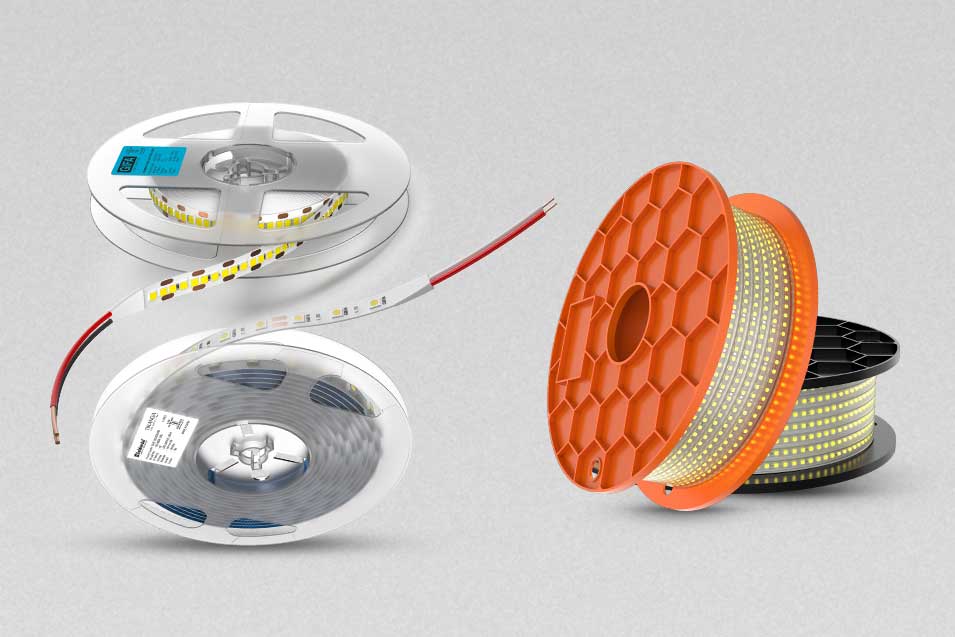
What is the difference between LED strip lights and rope lights?
LED strip lights and rope lights are popular choices for adding illumination and ambiance to your indoor or outdoor spaces. Although both are widely used for versatile lighting solutions, few people are aware of the differences between them. In this blog, we’ll explore the key differences between LED strip lights and rope lights, as well as their impact on lighting.
Structure and Appearance:
- LED Strip Lights: These lights consist of individual LEDs mounted onto a flexible strip that can be cut to custom lengths. In LED strip lights, the LEDs are closely spaced, providing a continuous line of light. They have a sleek and modern appearance and are available in various colours, including RGB (Red, Green, Blue), allowing for dynamic colour changes. They need an external constant voltage SMPS power supply to operate the LED strip. These lights are commonly provided with blue gumming tape to be mounted on the aluminium profile for the best lighting effects.
- Rope Lights: Unlike LED strips, these lights are encased in a clear, tubular casing that houses a continuous string of LEDs. They emit a more uniform and diffused light compared to LED strips. Rope lights are known for their soft, consistent glow and are available in a variety of single colours. These lights normally come with 220V, 50Hz powder adaptors to operate and do not require any SMPS power supply.
Flexibility:
- LED Strip Lights: LED strips are highly flexible and can be bent or curved to fit various shapes and spaces. This flexibility makes them ideal for intricate lighting designs and for accentuating architectural features.
- Rope Lights: Rope lights are less flexible than LED strip lights and cannot bend as much. They are best suited for straight lines or simple curves.
Customization:
- LED Strip Lights: LED strips are often sold in rolls of a specific length. The key advantage is that they can typically be cut at designated points, allowing for precise customization to fit your project’s dimensions. This makes them versatile for various project sizes. Be sure to check the manufacturer’s instructions for cutting guidelines.
- Rope Lights: Rope lights usually come in predetermined lengths and cannot be cut without damaging the wiring inside. This means that you need to select the appropriate length for your project from the start, which may result in some leftover material.
Brightness and Energy Efficiency:
- LED Strip Lights: LED strip lights are known for their high brightness and energy efficiency. They provide even and consistent illumination due to closely spaced LEDs making them suitable for task lighting. These lights are known for their energy efficiency, making them an eco-friendly choice. You can also find dimmable LED strips for adjustable brightness.
- Rope Lights: Rope lights emit light in all directions. But they tend to have a softer and less intense glow useful for decorative purposes and accent lighting.
The brightness of LED strips and Rope light depends on the number of LEDs used in them. Normally it comes with 60LED/120LED/240LED, the more the led the more brightness.
Use:
- LED Strip Lights: LED Strip lights are usually IP20 rating and used for indoor applications, especially for cove and profile lighting.
- Rope Lights: Rope lights have an IP65 rating and are suitable for outdoor applications like poles, garden areas, entertainment areas, etc.
Conclusion
In the LED strip lights vs. rope lights debate, both options have their unique characteristics and advantages. LED strip lights are more versatile and offer precise customization, making them ideal for creative lighting designs. On the other hand, rope lights are known for their uniform and soft glow, making them a popular choice for decorative and accent lighting.
The choice between LED strip lights and rope lights ultimately depends on your specific needs, design preferences, and budget. Consider the desired brightness, flexibility, and appearance you want to achieve, whether indoors or outdoors, to make an informed decision. Whichever you choose, both LED strip lights and rope lights have the potential to transform your space with captivating illumination.
Frequently Asked Questions (FAQs) :
Q1. What is the lifespan of LED strip lights?
LED strip lights typically have a lifespan ranging from 25,000 to 50,000 hours, although high-quality strips can last up to 70,000 hours. Factors like heat dissipation, voltage and current settings, component quality, usage patterns, and environmental conditions can significantly influence their longevity.
Q2. What is the lifespan of rope lights?
The lifespan of rope lights varies depending on the type of bulb used. Traditional incandescent rope lights typically last around 25,000 hours, while LED rope lights can last much longer, often up to 50,000 hours or more. The durability and longevity are also influenced by factors such as usage patterns and environmental conditions.
Q3. Do LED strip lights use more energy than rope lights?
LED strip lights are generally more energy-efficient than traditional incandescent rope lights. While LED strips use less energy to produce the same level of brightness, incandescent rope lights consume more power for equivalent illumination.
Q4. Can I use LED strip lights outdoors?
Yes, LED strip lights can be used outdoors, but it is crucial to ensure that they are specifically rated for outdoor use. These outdoor-rated strips are typically waterproof and designed to withstand various weather conditions.
Q5. Are rope lights suitable for intricate designs?
Rope lights, with their flexible and durable design, are well-suited for creating intricate designs and shapes. However, their larger diameter and less precise light direction compared to LED strip lights might limit the intricacy and sharpness of the designs achievable.
Q6. Can I cut LED strip lights to fit a specific length?
Yes, you can cut LED strip lights to fit specific lengths. Most LED strips have designated cutting points, usually marked with a line or scissors icon, allowing for safe and easy customization to your desired length.

